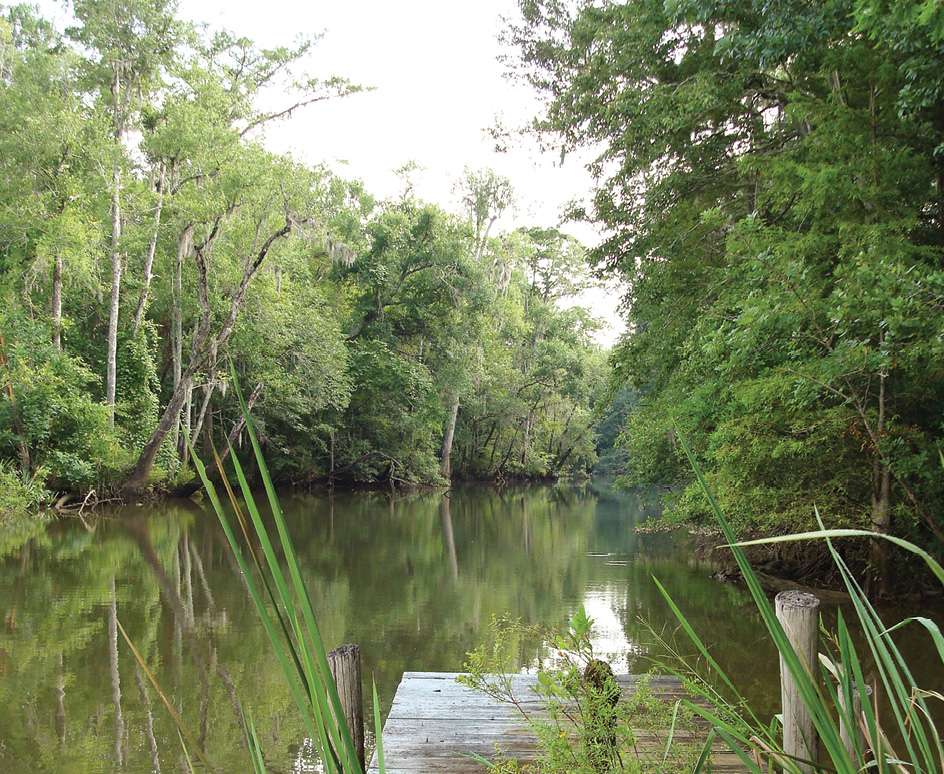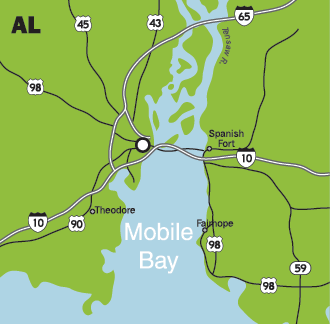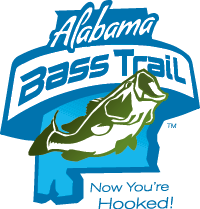
The Mobile-Tensaw River Delta can swallow you up and spin you around the first time you fish here. Its nearly 25,000 acres of water include riverine stretches, a vast marsh, huge grass flats and a maze of backwater sloughs, creeks and lakes.
Finding your way back to the ramp can be more challenging than catching bass. However, if you enjoy solitude, a rich natural environment and terrific bass fishing, put the Mobile-Tensaw River Delta on your must-fish list.
“You can fish here and never see another boat all day,” says local bass sage Jerry P. Davis, who has plied the delta for more than four decades.
The delta has three distinctly different fishing areas, Davis points out. Local anglers call them the Causeway, the Middle Delta and the River System.
THE CAUSEWAY
“From Gravine Island south to the I-10 highway bridge is the area we call the Causeway,” Davis says.
About 12 miles in width, the Causeway is composed of shallow bays and an abundance of aquatic vegetation, mainly milfoil and eelgrass. It also has what Davis calls “an overpopulation of bass.”
At certain times of the year, you can catch 30 to 50 bass a day from the Causeway. Autumn is one of those magical times. The drawback is that most of these bass weigh less than 2 pounds. It’s a great place to enjoy fast action, but not to win a tournament.
“You’ll cull through 50 bass to get a five-fish limit that weighs 8 to 10 pounds,” Davis says. “You’ll also catch a lot of redfish and speckled trout there.”
THE MIDDLE DELTA
 From Gravine Island north to just north of the I-65 bridge is what local bass fishermen call the Middle Delta. The creeks and streams that feed the Mobile and Tensaw rivers lead to as many as 20 lakes scattered throughout this region.
From Gravine Island north to just north of the I-65 bridge is what local bass fishermen call the Middle Delta. The creeks and streams that feed the Mobile and Tensaw rivers lead to as many as 20 lakes scattered throughout this region.
Some of these lakes are deep; others are shallow. Some lakes teem with grass, while others have little vegetation. All of them harbor bigger bass than those in the Causeway.
“You won’t catch as many bass here, but this is where you can sack limits that weigh 15 to over 20 pounds,” Davis says.
The best fishing in the Middle Delta happens from October through April. Each lake is unique and must be fished differently, Davis adds.
THE RIVER SYSTEM
 “We call the area north of the I-65 bridge the River System,” Davis says.
“We call the area north of the I-65 bridge the River System,” Davis says.
This more riverine section includes the Alabama River, the Tombigbee River and the small tributaries that feed them. Both the Alabama and Tombigbee rivers yield quality bass, Davis stresses.
The Alabama River lies to the east of the Tombigbee and is the clearer of the two. It also has sand, gravel and rocky bottoms, whereas the Tombigbee has a softer mud bottom.
“The rivers get better in the summertime when the water temperature gets higher,” Davis says. “Fresh water flows through them, and there is less tidal influence than farther south.”
THE TIDES
Davis insists that anyone fishing the delta must follow this basic rule of thumb: “On an incoming tide, the fish bite the least; on an outgoing tide, fish bite the best.”
“That’s not to say you can’t catch bass on an incoming tide,” Davis says. “You’ll just do better when the tide is going out.”
Key fishing locations on an outgoing tide are creek mouths, outside river bends and points, Davis claims.
ALABAMA BASS TRAIL SOUTHERN OPENER
 The first of five tournaments in the South Division of the Alabama Bass Trail happens at the Mobile-Tensaw River Delta on March 1, 2014. There are also five events slated for the North Division.
The first of five tournaments in the South Division of the Alabama Bass Trail happens at the Mobile-Tensaw River Delta on March 1, 2014. There are also five events slated for the North Division.
Each tournament has a $10,000 guaranteed first-place prize and pays 20 places. You can also qualify for a no-entry-fee championship with a grand prize of a 2015 fully rigged Phoenix 619 Pro bass boat.
“If we have a warm spring, the bass will be bedding all over the place in March,” Davis says.
In the Causeway, the bass will bed in holes they create by wallowing in the grass, Davis points out. Cypress trees hold spawning bass in the Middle Delta, while bass farther north in the River System will spawn in small creeks and behind sandbars and rock jetties just out of the river’s current.
“You’ll catch 4- and 5-pound spotted bass up there in March,” Davis says.
MEET JERRY P. DAVIS
For the entirety of his 67 years, Jerry Davis has lived in and around Bay Minette, Ala., which is a short cast from the Mobile-Tensaw River Delta. He has chased bass on this diverse fishery for the past 45 years and still gets after them two to three days a week.
Davis knows the delta so well he can almost feel its tides coursing through his veins. He has caught bass throughout this system, from the brackish water of the I-10 bridge north to where the Alabama and Tombigbee rivers merge to give birth to the Mobile-Tensaw River Delta. Follow Davis’ sage advice to make the most of the delta’s superb bass fishing.
FYI
Go to www.alabamabasstrail.org for information about Mobile-Tensaw River Delta fishing locations, productive patterns, local guides, campgrounds, where to stay and current river data. This website also has information about nine Alabama reservoirs and one other major river system.





